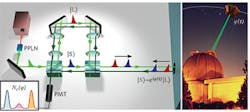Single photons interfere even at ground-to-satellite distances

Researchers from the University of Padova (Padova, Italy) and the Italian Space Agency (Matera, Italy) have experimentally demonstrated that single-photon interference can occur at a ground station because of the coherent superposition of the temporal modes of two single photons reflected by a satellite moving at an altitude of 5000 km. The finding confirms that quantum physics can take place at arbitrarily long distances, furthering the study of terrestrial and space-based quantum communications and computing applications.
In the experiment, photon packets are generated at a 532 nm wavelength using a mode-locked, optical-clock-stabilized, 100 MHz repetition-rate laser sent into a Mach-Zehnder interferometer. The quantum states are generated by halving a very short light pulse and then delaying the second pulse from the first by 3 ns. The two pulses are directed to the satellite and the back-reflected pulses, heavily attenuated because of the long transmission distance, are received by the telescope of the Matera Laser Ranging Observatory. Because of the high losses, the mean intensity of the received signal is well below a single photon per pulse. The two quantum states are then recombined, allowing the observation of their interference with single-photon detectors. The satellite motion with respect to the ground station, which may reach several kilometers per second, modulates the two reflected pulses, creating a continuous variation of the interference pattern. The observation of this modulation allows the researchers to clearly identify the interference effect on the detected photons.
These results are the latest in a series of milestones from the same research group, including the first demonstration of a single-photon exchange from space (2008), the first quantum communication from a low-earth-orbit (LEO) satellite (announced in 2014 and published the following year), and the extension to the medium-earth-orbit (MEO) range of the photon exchange (2015, published in January 2016). Reference: G. Vallone et al., accepted for publication in Phys. Rev. Lett. (May 24, 2016).
About the Author

Gail Overton
Senior Editor (2004-2020)
Gail has more than 30 years of engineering, marketing, product management, and editorial experience in the photonics and optical communications industry. Before joining the staff at Laser Focus World in 2004, she held many product management and product marketing roles in the fiber-optics industry, most notably at Hughes (El Segundo, CA), GTE Labs (Waltham, MA), Corning (Corning, NY), Photon Kinetics (Beaverton, OR), and Newport Corporation (Irvine, CA). During her marketing career, Gail published articles in WDM Solutions and Sensors magazine and traveled internationally to conduct product and sales training. Gail received her BS degree in physics, with an emphasis in optics, from San Diego State University in San Diego, CA in May 1986.